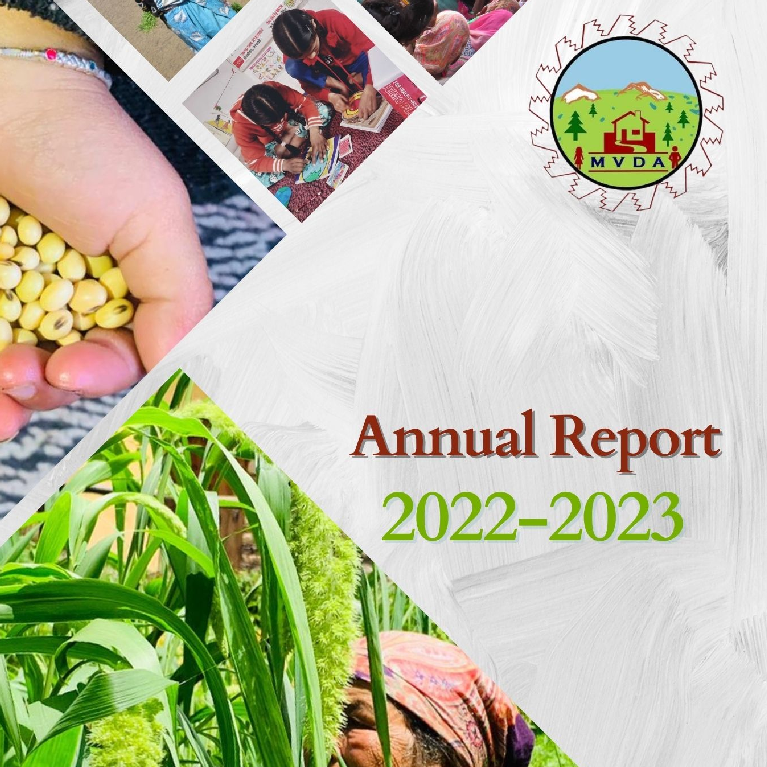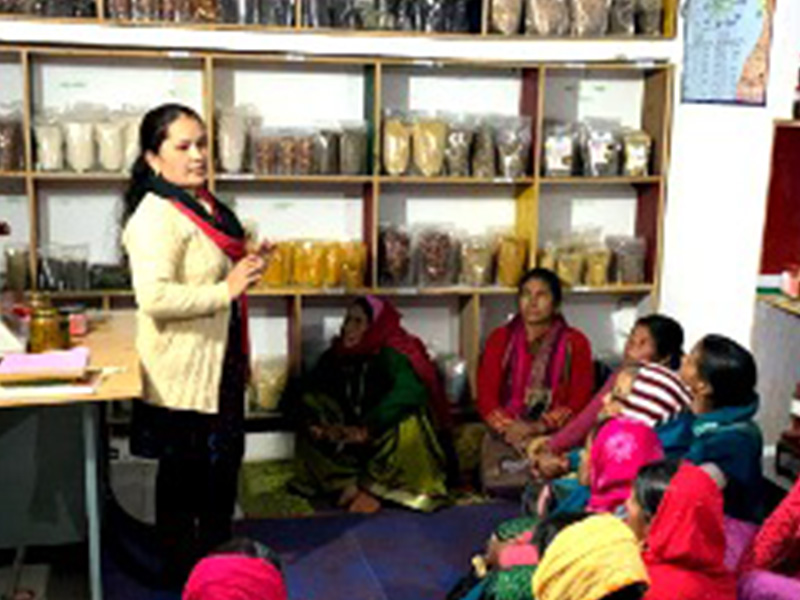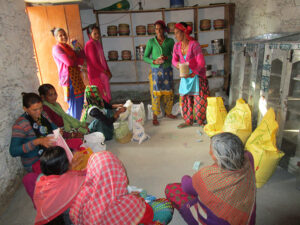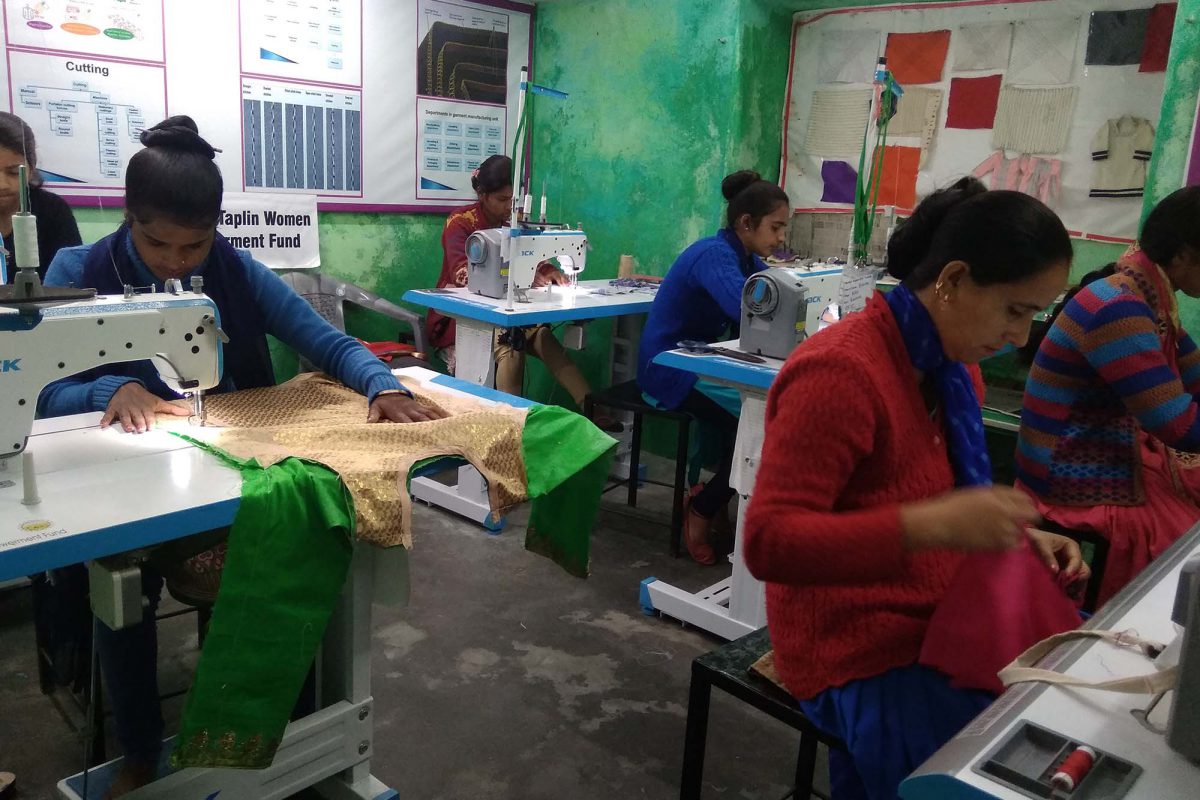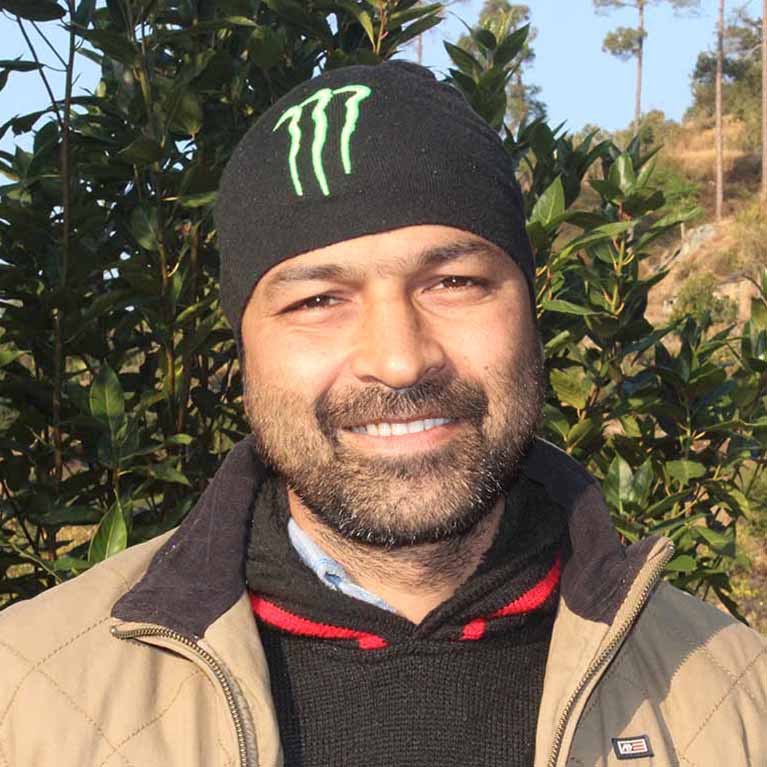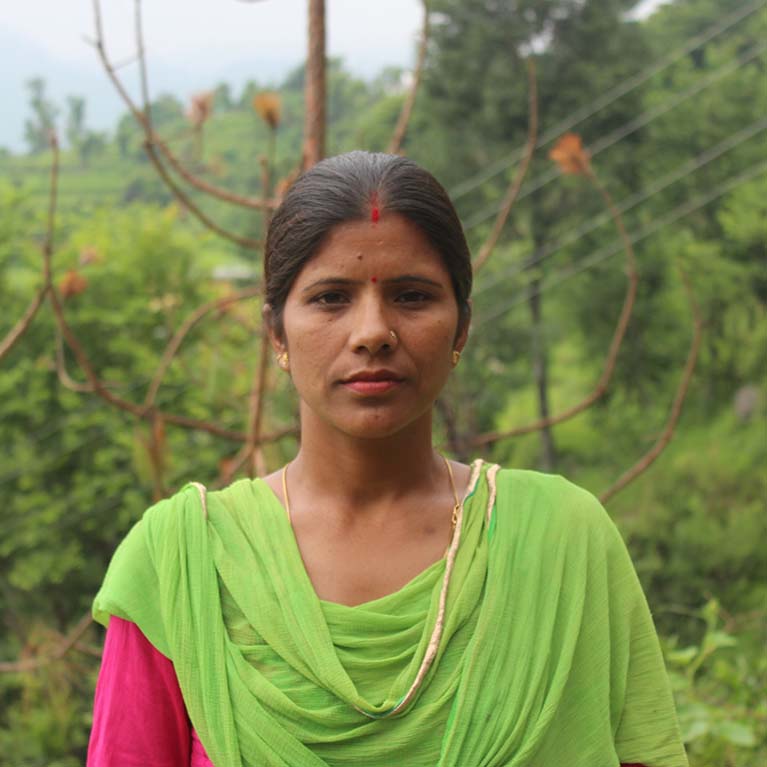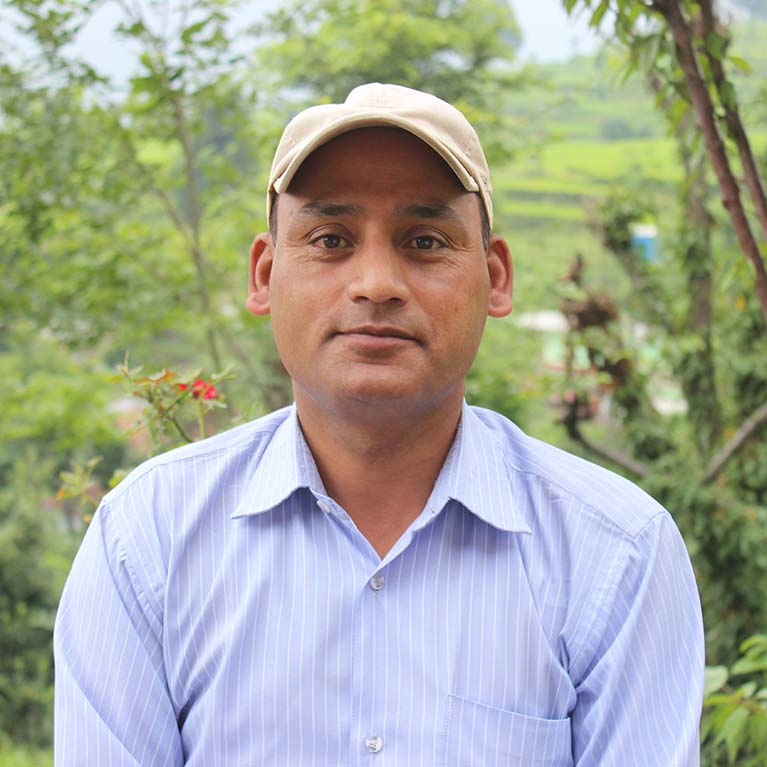#ruraldevelopmentngos
Ashes to Artistry
In the ever-changing cycle of nature, pine trees gracefully shed their needles each year, a process that ensures their continued health. These fallen needles, eventually decomposing, make way for new growth. However, it is important to understand the implications of dried pine needles in certain contexts. With their high resin content, dried pine needles become highly flammable, posing a fire risk, particularly during dry conditions. This vulnerability can lead to forest fires, causing extensive damage and threatening ecosystems.
Beyond the risk of fires, pine needles can also hinder the growth of new plants. Their presence on the forest floor blocks sunlight and moisture, creating an inhospitable environment for emerging flora. Biodiversity may suffer as the layer of pine needles becomes an obstacle for the establishment and development of new plant life.
opportunity to transform pine needles into something remarkable. Handicrafts made from pine needles offer a means to reduce waste and contribute to environmental sustainability. By repurposing this natural resource, we divert pine needles from landfills and incinerators, effectively reducing the burden on our ecosystems. Furthermore, the utilization of pine needles in handicrafts helps diminish the demand or synthetic materials, which often come at a great cost to the environment.
The potential for creativity with pine needles knows no bounds. Skilled artisans can weave, braid, and sew these needles, known as “piltu” or “pirul” in the local language, into an array of beautiful and functional objects. From baskets and mats to coasters, baskets and keychains, pine needle handicrafts offer a diverse range of possibilities. Engaging in this art form transcends age barriers, providing an enjoyable and rewarding activity for all. It not only encourages creativity but also fosters the acquisition of new skills, allowing individuals to forge a deeper connection with nature and appreciate its inherent beauty.
In the pursuit of preserving traditional crafts and empowering artisans,organizations like the Mount Valley Development Association (MVDA) stand as beacons of support. MVDA provides a platform for talented individuals, offering them an opportunity to showcase their skills and contribute to a more environmentally conscious society. Through training programs and workshops, this organization equips artisans with the necessary knowledge and techniques to excel in pine needle crafting. For many artisans, MVDA has been a transformative force, allowing them to break free from societal constraints and become financially independent.
As we embrace the potential of pine needles and their role in handicrafts, we embark on a journey that merges creativity, sustainability, and appreciation for the natural world. By repurposing these discarded needles, we can reduce waste, minimize environmental impact, and create unique pieces that celebrate the beauty of nature. The art of pine needle handicrafts not only enriches our lives with exquisite creations but also empowers artisans and supports organizations like MVDA in their mission to foster positive change. Together, we can weave a tapestry of creativity, resilience, and environmental stewardship, leaving a lasting impact on both our communities and the planet we call home.
Rural Girl Child Education: Shaping The Future Of Tomorrow
In today’s time, rural development education programs have emerged as a ray of hope for an enormous number of students. It has not only helped them shape their future but has also extended a prosperous lifestyle. Among all the rural students, the most benefited section of the students are girls. They have attained the best quality education and assistance
Education is an important asset for the overall development of the world. It helps in the flourishment of the nation as well as its people. However, a larger section of the world is acquiring the best quality education at primary, secondary, and higher secondary levels. Unfortunately, most students and youth enrolled at the educational institutes are male figures of society. In many parts of the world, especially India, rural girls are deprived of rights and responsibilities. This is because they are deprived of education as well as educational resources.
Understanding the importance and implementation of education in rural areas, the Mount Valley Development Association (MVDA) has emerged as a greater source of help for the larger section of the female population. MVDA is a civil society actor that works towards improving the lives of rural people, especially girl children by promoting girls education programs. The past success stories of MVDA establish a definite definition and worth of rural development education programs.
In this blog, we will discuss the role of educational programs in rural areas that help shape the girl child’s cognitive future.
Access to premium quality education
The majority of girls in rural areas are deprived of education. They don’t have access to educational resources due to various reasons like-
- Poor infrastructure
- Ruptured transportation
- Unavailability of teachers
- Lack of education resources.
Rural development education programs and girls education programs work effectively in areas with limited educational resources. With the help of experts and qualified educators, they help in the construction of schools as well as an efficient road that eliminates the hurdles in girls education. Establishing schools in the nearby locality helps the girls with better safety, which is one of the prime reasons for poor attendance of girls in class, as it eliminates the problem of distance travelling to school.
Provision of gender-centric curriculum
The complete academic structure of the rural education program is designed keeping in mind the comfort of female students. The well-designed structure of the academic session is gender-responsive, which focuses on meeting the requirements of girls in the form of proper education related to:
- Reproductive health
- Hygiene health
- Gender equality
- Life skills
- Future scope
The proper education on the above mentioned helps them form a well-defined decision for their life.
Offers complete monitoring
Rural educational programs are well-designed to keep a complete record of every child’s evolution. The curriculum under rural development education programs is designed to keep a proper vigilance on every child’s complete development. The assigned educator keeps the complete records of every particular student, especially girls. They highlight the strength of the girl child so that she can be polished for future endeavours and earn the potential to work efficiently in their respective field.
Additional support for future education
There are multiple recorded cases of girls dropping out due to lake of money. The financial burden is one of the prime reasons among the girl’s students. The rural educational programs are well known for offering better financial aid to female students in the form of scholarships and or other financial assistance. These help in multiple ways. Like
- Continuing their further education
- Minimises the dependency on parents/benefactor(s).
- Access to better resources such as books, uniforms, etc.
- Covers school fees
- Provides membership to libraries, educational websites, e-books, etc.
Breaking community barrier
Rural development education programs are a well-defined procedure to perform community engagement. The systematic and engaging practices to engage the community members help educate them in various ways.
- People are made aware of women’s capabilities.
- They are made to understand the importance of education for all concepts.
- It helps in breaking the cultural norms related to female education.
In recent years, rural areas have seen a spike in the number of women securing jobs in various sectors of life. Additionally, the rural people are coming forward to extend their support in the rural educational programmes’ strategies, which aim to shape the future with females equally responsible for the success.
Life skills and vocational training
Apart from contemporary education, there are various life skills as well as vocational courses that offer a better growth opportunity in life. Rural development education programs also hold the best provision of teachers who are well-trained to deliver the best life skills to the students. These life skills and vocational training courses help the girls earn a reputation and financial freedom in the world.
Promotes women empowerment
It is globally acclaimed that an educated woman is an extra step towards a better tomorrow. With the same ideology, girls education programs are preparing female students so as to take the lead in the various job fields. Apart from educating them, rural development education programs help female students with overall development. However, the results have started their effect on the larger section of the population, especially women. As the women in every field, whether it be medicine, engineering, corporate, etc., 02 out of 10 women hold a rural background.
Key points to consider about rural development education programs
There are several beneficial aspects of promoting girls education through various girls education programs. In order to make the best of the education, rural development education programs make the best use of resources in order to provide the following to aspiring female students.
- They offer the best-in-class education for every class/subject.
- Makes an appropriate atmosphere for the flourishment of every student.
- Perform complete surveillance for every student’s complete growth.
- Extends additional support in the form of scholarships and additional support.
- Educates the community about the importance of female education.
- Apart from mainstream education, it prepares students for every other field of life.
- Encourages women’s participation and leadership in every work sector.
Final words!
It is said that every child deserves the right to education, so why the rural girls be deprived of it? Busting the fact, it is evident from the above discussion that female education is our best foot forward to a better nation. In doing so, Under rural development education programs, we, the Mount Valley Development Association (MVDA), work effortlessly to render the best quality education to every female child in the mountain region. The majority of female students in the mountains are deprived of their education rights due to financial shortcomings, domestic pressure, and low self-esteem to perform something new. With the effort of experient members, we invest our best effort at bringing change in the lives of female students.
If you also aim the same and want to contribute to the betterment of the, join your hand with the rural development education programs with us. With years of experience, we work for the country’s economic empowerment. In order to do so, we strengthen and improve the quality of life of the rural population. Our prime agent in providing service to the rural community is educating the youth with a special focus on girl child education.
Community Seed Bank: Empowering Sustainable Agriculture
Introduction:
A Community Seed Bank is a vital component of community agriculture, encompassing local gardens or fields where traditional varieties are safeguarded. This system empowers farmers in the creation, maintenance, and promotion of crop genetic diversity. Seed banks serve as repositories of local genetic diversity, adapted to prevailing climate conditions and resistant to crop pests. They enhance resilience, food security, and the benefits of sustainable agriculture, making them indispensable for a prosperous and ecologically balanced future.
Community Seed Bank: Concept And Practices
Community Seed Banks exemplify sustainable agriculture’s power to envision a resilient and prosperous agricultural future. They are locally governed and managed collective-action institutions, primarily responsible for preserving seeds for local use. Their mission involves conserving, restoring, revitalizing, strengthening, and enhancing plant genetic resources for food and sustainable agriculture. This effort extends to local varieties, major and minor crops, as well as neglected and underused species. Across the globe, Community Seed Banks empower farmers and communities, enabling them to regain, maintain, and expand their control over the seeds they rely on. This often results in enhanced cooperation among farmers and other stakeholders such as plant breeders, agricultural researchers, and gene bank managers, all committed to conserving and sustainably using agricultural biodiversity.
Local varieties often serve as the primary source of planting material for small-scale farming, playing a crucial role in adapting to local environmental conditions. Community Seed Banks promote on-farm conservation by collecting and preserving locally adapted seeds, typically underserved by formal seed systems and markets. Preserving landraces and farmer’s varieties is essential as they harbor traits like resistance to biotic and abiotic stresses, as well as vital nutritional qualities necessary for productivity. Additionally, Community Seed Banks play a pivotal role in ensuring the availability and accessibility of diverse genetic resources in sufficient quantities during planting seasons.
Objectives of Community Seed Bank
The Community Seed Bank Project has several key objectives:
i) To conserve indigenous and interspecies variation suited to the local ecological niche.
ii) To integrate on-farm conservation through community participation.
iii) Collection, selection, and production of indigenous crop diversity.
iv) Ensuring high-quality seed and planting material production.
v) Reducing farmer dependency on public and private seed supply systems and strengthening farmer-to-farmer exchange networks.
vi) Providing infrastructure for storage facilities and developing a resource and training center for the community.
vii) Encouraging the use of locally adapted seeds to reduce the need for chemical inputs, promoting eco-friendly agricultural practices and sustainable agriculture.
Regardless of scale, establishing and supporting a community seed bank involves a logical sequence of steps that carefully align community interests and needs with seed bank principles and practices.
Establishing A Community Seed Bank
Community Seed Banks often provide training and education to farmers, offering insights into seed-saving techniques, sustainable agriculture benefits, and the significance of crop diversity. The process of establishing and supporting a Community Seed Bank encompasses several major steps. It’s crucial to approach this process systematically, prioritizing human and social aspects before physical infrastructure. A “five-star” community seed bank building is valuable only if farmers are motivated and equipped to utilize it effectively.
There are nine major steps in establishing and supporting a community seed bank:
- Situational analysis.
- Motivating and organizing farmers.
- Choosing crop species and varieties.
- Seed health (local quarantine) and seed processing (cleaning).
- Seed storage (facility, equipment, and methods).
- Registration of new varieties (passport data).
- Seed regeneration.
- Information sharing.
- Monitoring operations and results.
Importance Of Community Seed Bank
Various rural development NGOs actively promote the establishment of Community Seed Banks, preserving genetic diversity, enhancing food security, and supporting eco-friendly farming practices. Collaborations with local communities foster self-reliance and resilience. Community Seed Banks not only encourage the use of locally adapted seeds but also reduce reliance on external seed sources, leading to eco-friendly and sustainable agriculture practices.
How Long Do Seeds Survive In A Seed Bank
Seeds stored in these vaults can theoretically remain dormant for hundreds or even thousands of years, depending on the species. However, these projections are based on models, as we await the first seeds to reach a 10,000-year mark. Best predictions suggest seeds will survive at least 150 years in these vaults.
Worldwide, there are about 1,500 seed banks, including the largest one, the Svalbard Global Seed Vault, located on the remote Norwegian islands of Spitsbergen. Community Seed Banks differ from these massive institutions, operating on a smaller scale within specific communities, which enhances their impact.
Conclusion
Maintaining a healthy and dynamic Seed System is crucial for realizing the benefits of sustainable agriculture. Limited access to innovation and a lack of diversity can lead to agricultural specialization in areas where it is suboptimal. Innovation gaps result in poor-quality planting materials and limited capacity to improve processing technologies for low-income farmers. Community Seed Banks play a pivotal role in maintaining genetic diversity at the community level, benefiting future generations. This grassroots initiative has a significant impact, promoting sustainable agriculture and resilient farming communities.
Harvesting Prosperity: The Benefits of Sustainable Agriculture
Sustainable agriculture integrates three main goals, environmental health, economic profitability and social and economic equity. It is a way to meet society’s present food and textile needs, without compromising the ability for current or future generations to meet there needs. It can be based on an understanding of ecosystem services. When agricultural operations are sustainably managed, they can preserve and restore critical habitats, help protect watersheds, and improve soil health and water quality.
Benefits of Sustainable Agriculture: A Holistic Approach
Sustainable agriculture offers multitude advantages, each contributing to a more balanced and resilient agricultural system. Rural development NGOs promote sustainable agricultural practices as they offer wide array of benefits.Here, we elaborate on the key benefits of sustainable agriculture:
1. Help Maintain Biodiversity:
Sustainable agriculture is a guardian of biodiversity, actively contributing to the preservation and flourishing of diverse ecosystems:
i) Crop Diversity:
One of the benefits of sustainable agriculture is that it encourages the cultivation of a wide range of crop varieties. Unlike monoculture farming, which relies on a single crop, diversified planting provides refuge and sustenance for numerous plant species. This diversity creates vibrant ecosystems within the field, attracting a variety of pollinators, insects, and microorganisms. These diverse plant communities also support a wide array of herbivores, further enriching biodiversity.
ii) Habitat Preservation:
Sustainable farming advantages often incorporates the preservation of natural habitats within or around farmlands. These preserved areas serve as sanctuaries for native flora and fauna, including various plant species, insects, birds, and mammals. By safeguarding these habitats, sustainable agriculture creates safe havens for biodiversity to thrive, promoting balanced ecosystems.
iii) Reduced Chemical Use:
Other benefit of sustainable agriculture is that, it minimizes the reliance on synthetic pesticides and fertilizers, which can have detrimental effects on non-target species. By decreasing chemical inputs, sustainable practices protect beneficial insects, such as pollinators and natural pest predators. This protection allows these essential species to flourish and contribute to overall biodiversity.
iv) Cover Crops and Crop Rotation:
Sustainable agriculture emphasizes practices like cover cropping and crop rotation, which enhance soil health and reduce the risk of soil-borne diseases. Healthy soils teem with a multitude of microorganisms and invertebrates crucial for nutrient cycling and plant growth, further promoting biodiversity.
v) Integrated Pest Management (IPM):
An integral part of sustainable agriculture, IPM focuses on monitoring and selective interventions to control pests. Instead of indiscriminate pesticide use, IPM seeks to balance pest populations, minimizing harm to non-target species and fostering a more harmonious ecosystem within the farming environment.
vi) Genetic Diversity Preservation:
Benefits of sustainable agriculture often includes the conservation of traditional and heirloom crop varieties. These varieties may carry unique genetic traits vital for crop resilience in changing environmental conditions. By preserving genetic diversity, sustainable agriculture safeguards the future of numerous plant species.
2. Make the Most Effective Use of Non-Renewable and Farm Resources:
Sustainable agriculture optimizes resource utilization, making efficient use of both non-renewable and farm resources:
i) Precision Farming Techniques:
Sustainable agriculture leverages precision farming technologies, such as GPS-guided equipment and soil sensors. These tools enable farmers to apply resources like water, fertilizers, and pesticides with pinpoint accuracy. This targeted approach reduces resource waste, ensuring that inputs are used only where needed.
ii) Organic Matter Management:
Effective organic matter management, including practices like composting and mulching, improves soil structure and nutrient retention. Healthy soils can efficiently store and release essential elements to plants, reducing the need for excessive fertilization. This is also among the important benefits of sustainable agriculture.
iii) Efficient Irrigation Practices:
Sustainable agriculture advantages include prioritizing efficient irrigation methods, such as drip and micro-irrigation systems. These techniques deliver water directly to the root zone of plants, minimizing water wastage through evaporation or runoff.
iv) Local and Sustainable Sourcing:
Sustainable agriculture often involves sourcing inputs locally, reducing the environmental footprint associated with transportation. This approach not only supports local economies but also minimizes the carbon footprint of farming operations.
3. Maintain the Economic Viability of Farm Operation:
The benefits of sustainable agriculture includes that farms remain economically viable while implementing practices that benefit the environment:
i) Niche Markets:
Sustainable agriculture often opens doors to niche markets that value environmentally friendly and locally sourced products. These markets can provide farmers with higher returns for their produce, enhancing the economic viability of their operations.
ii) Reduced Input Costs:
By reducing the reliance on synthetic chemicals and excessive fertilizers, sustainable agriculture lowers input costs. This financial relief can significantly impact the economic sustainability of farms, especially small-scale operations.
iii) Minimized Environmental Risks:
One of the key benefits of sustainable agriculture practices is that, it reduces the environmental risks associated with farming, such as soil erosion, water contamination, and habitat destruction. This reduces the potential for costly environmental damages or regulatory fines that could negatively impact farm economics.
4. Rejuvenate the Original Growth of the Plant:
Sustainable agriculture advantages includes that it endeavors to rejuvenate and enhance the natural growth of plants:
i) Soil Health Improvement:
Prioritizing soil health through organic matter enrichment, reduced chemical usage, and enhanced nutrient management is one of the important benefits of sustainable agriculture. Healthy soil provides an ideal environment for plant roots to access essential nutrients and water. Consequently, crops grow robustly, mirroring their natural, vigorous growth patterns.
ii) Reduced Chemical Dependency:
Sustainable agriculture minimizes the use of synthetic pesticides and synthetic fertilizers. By opting for organic and eco-friendly alternatives, it ensures that plants are not subjected to the stress and damage often caused by chemical exposure. This reduction in chemical dependency fosters healthier plant growth.
iii) Crop Rotation:
Sustainable agriculture practices like crop rotation change the types of crops grown in specific fields over time. This technique helps prevent soil depletion and the buildup of crop-specific diseases, creating improved conditions for plant growth.
iv) Biodiversity Promotion:
Sustainable agriculture incorporates diverse crop varieties and encourages the growth of cover crops. This biodiversity promotes symbiotic relationships among plants and beneficial microorganisms, enhancing overall plant health and vigor.
PRINCIPLE OF SUSTAINABLE AGRICULTURE
1. Protecting and Improving Natural Resources:
Sustainable agriculture recognizes the inherent value of our natural resources and takes deliberate steps to safeguard and enhance them making it one of the important benefits of sustainable agriculture.
i) Soil Health Preservation
Practices like reduced tillage, cover cropping, and organic matter enrichment are employed to protect and rejuvenate soil health. These efforts not only prevent soil erosion but also foster a nurturing environment for plants growth.
ii) Water Conservation
Efficient water management is integral to sustainable agriculture. Techniques like drip irrigation and rainwater harvesting are embraced to minimize water wastage. This not only conserves a precious resource but also prevents water pollution, benefiting ecosystems downstream.
iii) Biodiversity Promotion
Biodiversity is the cornerstone of healthy ecosystems. One of the key benefits of sustainable agriculture is that it actively encourages diverse planting, preserving natural habitats, and reducing chemical use. These practices attract beneficial insects, pollinators, and foster a balanced ecosystem within farmlands.
2. Enhancing Rural Development and Social Welfare
Sustainable agriculture goes beyond crop yields; it aims to improve the quality of life for those involved in farming. Rural development NGOs also promote sustainable agriculture.
i) Promoting Rural Development
By promoting sustainable practices, rural communities are empowered to take control of their agricultural destinies. This self-reliance leads to economic stability and a sense of ownership in rural areas.
ii) Access to Nutrient-Rich Food
Sustainable agriculture often results in nutrient-dense crops. This translates to better access to healthy food, benefiting not just farmers but the entire community.
iii) Cultural Preservation
Sustainable agriculture respects local traditions and heirloom crop varieties. By preserving cultural heritage, it contributes to the enrichment of rural development.
3. Improving the Efficiency of Resource Utilization
One of the key benefits of sustainable agriculture is efficiency and making the most out of every resource.
i) Precision Farming
Cutting-edge technology is harnessed for precision farming. GPS-guided tractors, soil sensors, and data analytics are used to optimize resource use. This ensures that inputs like water, fertilizers, and pesticides are applied with pinpoint accuracy, reducing waste.
ii) Organic Matter Management
Effective organic matter management, including composting and mulching, enhances soil fertility and structure. This enables the soil to retain and release nutrients efficiently, reducing the need for excessive fertilization.
iii) Integrated Pest Management (IPM)
IPM is the art of pest control without the unnecessary use of chemicals. By monitoring and selectively intervening, sustainable agriculture maintains a balanced ecosystem where natural predators keep pest populations in check.
These principles are not just guidelines; they are a path to a thriving tomorrow where farming nourishes both people and the planet.
Methods of Sustainable Agriculture
Sustainable agriculture is a beacon of hope for the future of farming, emphasizing practices that enrich both the soil and the human spirit. The key methods of sustainable agriculture and how they cultivate resilience, diversity, and ecological harmony are explained as below.
i) Permaculture: Designing with Nature
Permaculture, short for “permanent agriculture” or “permanent culture,” is a regenerative approach to farming that mimics natural ecosystems. It centers on careful design, emphasizing synergy between plants, animals, and landscapes.
Permaculture principles include designing diverse and resilient systems, minimizing waste, and building healthy soil. By creating food forests, incorporating rainwater harvesting, and practicing “no-dig” gardening, permaculture fosters self-sufficiency and sustainable abundance.
ii) Cover Crops: Nature’s Blanket
Cover crops, also known as green manure, are non-commercial crops planted to cover and protect the soil between main crops. They act as a living mulch, preventing erosion, suppressing weeds, and improving soil health.
Legumes like clover and vetch fix nitrogen in the soil, reducing the need for synthetic fertilizers. Meanwhile, deep-rooted plants like radishes break up compacted soil, enhancing water infiltration and aeration. The result is healthier, more fertile soil that supports robust crop growth.
iii) Polyculture Farming: Nature’s Harmony
Polyculture farming is a departure from monoculture, where multiple crop species are cultivated together. This mimics natural ecosystems, reducing the risk of crop failure due to pests or diseases.
Diverse plant communities promote nutrient cycling, deter pests naturally, and maximize the use of sunlight and soil resources. For instance, planting corn alongside beans and squash creates the “Three Sisters” system, where each crop supports the others, resulting in healthier and more abundant yields.
iv) Natural Pest Predators: Allies in Agriculture
Key benefits of sustainable agriculture include seeking harmony with nature, including harnessing the power of beneficial insects and organisms as natural pest control.
Ladybugs, lacewings, and parasitic wasps are nature’s warriors against crop-damaging pests. By creating habitat for these allies and reducing pesticide use, sustainable agriculture maintains a delicate balance where predators keep pest populations in check.
v) Soil Enrichment: Nourishing the Earth
Soil is the foundation of agriculture, and sustainable practices prioritize soil health. Soil enrichment involves adding organic matter like compost, leaf mulch, and cover crop residues to improve soil structure and fertility.
Healthy soil teems with beneficial microorganisms, earthworms, and other essential life forms. They break down organic matter, release nutrients to plants, and create a stable, crumbly soil structure that retains moisture and resists erosion.
vi) Crop Rotation:
Crop rotation is a time-honored practice where different crops are planted in the same field over time. This breaks the cycle of pests and diseases specific to certain crops, enhances nutrient cycling, and promotes soil health. For example, legumes like peas or beans are rotated with heavy-feeders like corn or tomatoes. The legumes fix nitrogen in the soil, enriching it for the subsequent crops.
Conclusion:
These methods and benefits of sustainable agriculture are a testament to humanity’s ability to work in harmony with nature. They cultivate resilience, embrace diversity, and nourish both the land and those who tend it. By adopting these practices, we can build a more sustainable and regenerative agricultural future that ensures food security and environmental health for generations to come.
Health
To catalyze the challenge of improving the quality of health facilities in mountain villages i.e Primary Health Center and Community Health Center. Accessibility to quality health care, besides shortage of doctors and paramedical staff are the main problems that rural people confront in the Uttarakhand state. MVDA helps community with support of its partner agencies to carry out different trainings for first aid at individual level for local communities for i.e. snake rescue, accidental primary care, bandaging, stitching etc.
Livelihood
Training, capacity building and linking to the market are the essential tools for the economic development of the villages. We are aiming to give the beneficiaries, liberty to earn for their family.
Training, capacity building and linking to the market are the essential tools for the economic development of the villages. We are aiming to give the beneficiaries, liberty to earn for their family.
